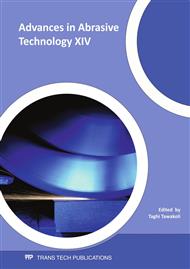p.523
p.530
p.536
p.542
p.548
p.557
p.563
p.570
p.576
Characterization of Silicon Carbide Grit for Fickerts Used in Porcelain Tile Honing and Polishing Process
Abstract:
This paper presents results of morphological and dimensional characterization of silicon carbide (SiC) abrasives used in production of fickerts for the rotary plane honing and polishing process of porcelain tiles. For morphological characterization scanning electron microscopy (SEM) and optical reflection microscopy images were analyzed by software to determine the circularity factor of the particles. In order to analyze the particle size dispersion sieving and laser diffraction were used. Five samples within the same batch of abrasives and with different sizes were characterized. The results show a uniform dispersion with a small variation of the particles size. Regarding the form of particles, the angularity increases in the samples with smaller size. The employed procedure for the analysis of circularity factor is a method frequently used to characterize SiC particles.
Info:
Periodical:
Pages:
548-554
Citation:
Online since:
August 2011
Keywords:
Price:
Сopyright:
© 2011 Trans Tech Publications Ltd. All Rights Reserved
Share:
Citation:


